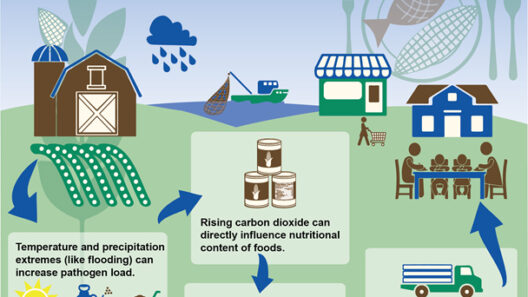Ocean acidification, often overshadowed by the more prominently highlighted global warming, significantly threatens our marine ecosystems. Dubbed as global warming’s “evil twin,” this phenomenon arises primarily from increased carbon dioxide (CO2) emissions. While many are acutely aware of rising temperatures affecting terrestrial environments, fewer grasp the complexity and urgency of ocean acidification.
As atmospheric CO2 concentrations escalate due to fossil fuel burning, deforestation, and various industrial activities, approximately 30% of this CO2 is absorbed by the world’s oceans. This absorption transforms the chemistry of seawater, reducing pH levels and leading to a more acidic marine environment. The current pH of ocean surface waters has declined by about 0.1 units over the past 150 years, signifying an increase in acidity of approximately 30%. Such changes may appear trivial, yet their ramifications are profound and multi-faceted.
One of the most significant and immediate impacts of ocean acidification is its effect on calcifying organisms, which include mollusks, corals, and certain plankton species. These organisms utilize calcium carbonate to form their shells and skeletons. As seawater becomes more acidic, the availability of carbonate ions—essential for calcium carbonate formation—diminishes. The result is a slowdown in calcification rates, leaving these creatures vulnerable to predation and adverse environmental conditions.
Coral reefs, often referred to as the rainforests of the sea, stand as a stark example of the potential disaster inflicted by acidification. Healthy coral reefs not only shelter immense biodiversity but also provide services vital to millions of people, offering food, coastal protection, and tourism revenues. However, as ocean acidity increases, coral reefs experience significant bleaching and degradation, compromising their structural integrity and the myriad species dependent upon them.
The repercussions of ocean acidification extend beyond marine life; they influence entire food webs. Phytoplankton, microscopic plants that form the foundation of the marine food chain, are affected by changes in ocean chemistry. These organisms perform photosynthesis and sequester carbon, playing a crucial role in regulating the Earth’s climate. A decline in phytoplankton health and population could impact fish stocks and ultimately human communities reliant on seafood for sustenance and economic stability.
Another aspect often underestimated is the interaction between ocean acidification and other stressors, such as temperature fluctuations, pollution, and overfishing. When synergistically combined, these stressors create an even more hostile environment for marine organisms. For instance, elevated temperatures can exacerbate the deleterious effects of acidification on coral reefs, leading to increased bleaching events that jeopardize reef resilience. Understanding these interactions is vital for predicting and mitigating the future impacts on marine ecosystems.
Furthermore, ocean acidification poses risks to human health. The fishing industry, a critical livelihood for over 200 million people worldwide, faces the threat of diminished fish stocks and altered species distribution. Aquaculture, a rapidly growing sector designed to meet increasing seafood demands, is similarly at risk. Shellfish, such as oysters and clams, are particularly vulnerable to acidified waters, with significant economic repercussions for coastal communities that depend on these species for income and nutrition.
The socio-economic implications lend urgency to the need for awareness and action. As the reality of climate change becomes increasingly undeniable, it is imperative to understand that ocean acidification represents another facet of a larger issue. The interdependence of atmospheric and oceanic health must be recognized, and efforts to mitigate carbon emissions must include strategies to address ocean acidification. Solutions could encompass enhancing coastline resilience, restoring habitats, and employing innovative technologies aimed at reducing carbon emissions.
Education plays a crucial role in addressing ocean acidification. Raising awareness about the complexities and dangers associated with this phenomenon is vital. Public knowledge fosters advocacy for policy change, which can lead to more stringent emissions regulations and protective measures for marine ecosystems. Engaging communities, particularly those that rely heavily on marine resources, in discussions about these issues can empower them to take action, fostering stewardship of the oceans.
In addition, scientists are exploring various methods to mitigate the effects of ocean acidification on marine life. Research is underway on selective breeding for resilience in shellfish and investigating the efficacy of algae cultivation as a natural buffer against ocean acidity. These innovative approaches illustrate the potential for scientific advancement to alleviate some impacts of human-induced changes to marine ecosystems.
Ultimately, addressing ocean acidification is not just an environmental necessity but also a moral imperative. Future generations deserve a vibrant ocean teeming with life, untainted by the consequences of unmanaged carbon emissions. Combatting this insidious threat requires collaboration among scientists, policymakers, industries, and communities worldwide. The interconnectedness of human activities and oceanic health must be recognized, reinforcing the idea that the fight against climate change is a collective endeavor.
In conclusion, ocean acidification emerges as a daunting challenge, an “evil twin” to the more overt impacts of climate change. Its insidious influence calls for immediate and sustained action, reinforcing the crucial need to pursue sustainable practices, mitigation strategies, and comprehensive educational programs. The ocean’s health is paramount not only for marine life but also for humanity’s future, making our response to these changes a pressing priority.




